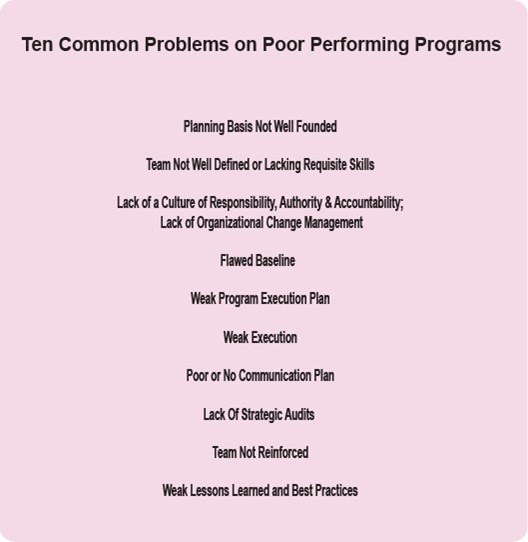SECOND EDITION
By Bob Prieto
Jupiter, Florida, USA
Program Management involves dealing with a scale and complexity that goes well beyond that experienced in many projects. These challenges are compounded by new linkages across multiple projects; indirect inter-dependencies as a result of “constraint coupling”; and new risks and opportunities which may lurk in the white spaces between projects. The greatest sources of poor performance in large programs, however, have more to do with the context and frameworks established than the new and often hidden risks.
This paper identifies ten common problems found on poor performing programs and provides the program manager with a convenient diagnostic tool to assess his program’s susceptibility to degraded performance. Periodic review of these problems experienced on many programs facilitates early corrective action and improved program performance.

- Planning Basis Not Well Founded
Large, complex programs require a well thought out and developed foundation upon which to build the program structure consisting of a program execution strategy and plan, a supporting organizational framework, and an infrastructure of processes and procedures that tie the program together. But just like any structure, programs will only perform as good as the foundation upon which they are built.
In programs experiencing problems related to an inadequately developed planning basis there are several root causes that are routinely identified. These include:
- Program team begins work without detailed program and project execution plans.
- Strategic Business Objectives (SBO) not well defined or communicated.
- Project team does not spend sufficient effort to gather and understand all relevant information
- Flawed planning assumptions driven by bias that limits consideration of best ideas
- Limited buy-in from the team
- Lack of team alignment results in a culture lacking trust setting the stage for micro-management, slowing the program down
A structured process, beginning with identification and articulation of Strategic Business Objectives, strategy definition, careful project portfolio selection, structured alignment and complementary organizational change management can help organizations avoid many of these planning basis problems.
More…
To read entire article, click here
Editor’s note: Second Editions are previously published papers that have continued relevance in today’s project management world, or which were originally published in conference proceedings or in a language other than English. Original publication acknowledged; authors retain copyright. This paper was originally published in PM World Today in August 2011. It is republished here with the author’s permission.
How to cite this paper: Prieto, R. (2011). Ten Common Problems on Poor Performing Programs, Second Edition, PM World Journal, Vol. X, Issue X, October 2021. Originally published in PM World Today, August 2011. Available online at https://pmworldlibrary.net/wp-content/uploads/2021/09/pmwj110-Oct2021-Prieto-Ten-Common-Problems-on-Poor-Performing-Programs.pdf
About the Author

Bob Prieto
Chairman & CEO
Strategic Program Management, LLC
Jupiter, Florida, USA
![]()
Bob Prieto is a senior executive effective in shaping and executing business strategy and a recognized leader within the infrastructure, engineering and construction industries. Currently Bob heads his own management consulting practice, Strategic Program Management LLC. He previously served as a senior vice president of Fluor, one of the largest engineering and construction companies in the world. He focuses on the development and delivery of large, complex projects worldwide and consults with owners across all market sectors in the development of programmatic delivery strategies. He is author of nine books including “Strategic Program Management”, “The Giga Factor: Program Management in the Engineering and Construction Industry”, “Application of Life Cycle Analysis in the Capital Assets Industry”, “Capital Efficiency: Pull All the Levers” and, most recently, “Theory of Management of Large Complex Projects” published by the Construction Management Association of America (CMAA) as well as over 800 other papers and presentations.
Bob is an Independent Member of the Shareholder Committee of Mott MacDonald and a member of the board of Dar al Riyadh. He is a member of the ASCE Industry Leaders Council, National Academy of Construction, a Fellow of the Construction Management Association of America and member of several university departmental and campus advisory boards. Bob served until 2006 as a U.S. presidential appointee to the Asia Pacific Economic Cooperation (APEC) Business Advisory Council (ABAC), working with U.S. and Asia-Pacific business leaders to shape the framework for trade and economic growth. He is a member of the Millenium Challenge Corporation advisory board where he had previously served. He had previously served as both as Chairman of the Engineering and Construction Governors of the World Economic Forum and co-chair of the infrastructure task force formed after September 11th by the New York City Chamber of Commerce. Previously, he served as Chairman at Parsons Brinckerhoff (PB) and a non-executive director of Cardno (ASX)
Bob serves as an honorary global advisor for the PM World Journal and Library and can be contacted at rpstrategic@comcast.net
To view other works by Bob Prieto, visit his author showcase in the PM World Library at https://pmworldlibrary.net/authors/bob-prieto/









